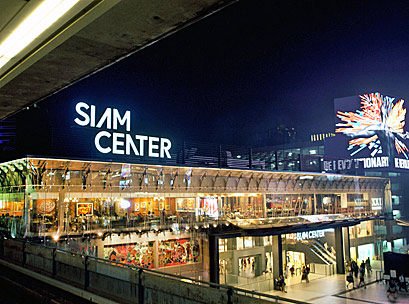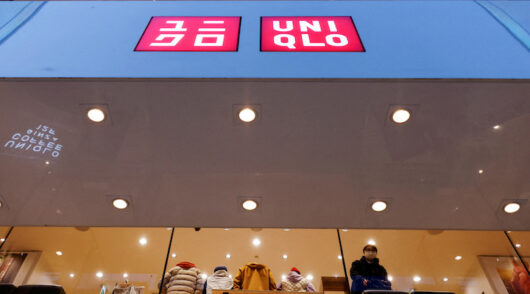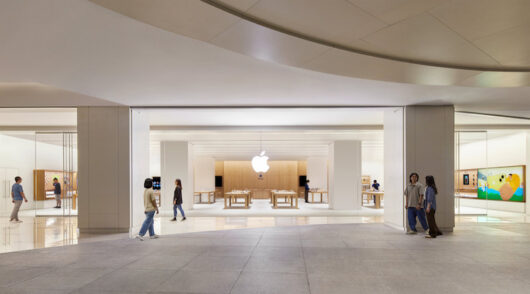Dwarfed by its newer neighbours, and at a time when retailers worldwide are gravitating to cookie cutter mega malls with the same core tenants, the 40 year old Siam Center has to be unique to survive.
In 25 years managing the centre her father built, this is the seventh revamp Siam Piwat CEO, Chadatip Chutrakul, has overseen – and by far the most radical.
“We are very good at finding a gap in the market. I decided to do something bigger malls cannot do,” says Chadatip.
Siam Center targets fashionable middle class Thais with discretionary income – whose ranks grow by the day.
“They’re wise enough not to be addicted to any one brand and can show off their style with mixing and matching.”
“Whether Thais or tourists or expatriates, they’re into technology. They’re done with TV and listening to the radio; everything comes online to them.”
So in Chadatip’s words: “We decided not to be a shopping centre any more.”
“This time I didn’t want to be a building without a soul. I wanted to have a building with its own character. That’s where I started.”
What she has achieved is the creation of a centre where every tenant offers something exclusive to the building via their stock offer and store design. There really is no other mall quite like it anywhere on the planet.
“We had to create something totally different. At the same time the brands need to be the best.”
“I knew it would not be easy to work with them and demand more because they don’t have to do anything.”
“The international brands are so dynamic they are dominant: everywhere you go you see brands like Zara and Uniqlo and whether you shop in Thailand, Hong Kong, Singapore or the US you see the same products.”
So there was Siam Center’s angle: “I challenged them: You can do more.”
When she had trouble getting the concept across to a retailer she would ask them: “Do you want to be in a shopping mall without character or one with a soul to it? Then the retailer really got it.”
Chadatip did have one position of strength with tenants – in 40 years Siam Center has never had vacant space and has always maintained a waiting list of companies wanting to enter.
New York’s Soho was her greatest inspiration.
“It inspires you. It mixes art and fashion and entertainment.”
“Everybody creates the best showcase to be different,” she adds, citing Prada as a prime example.
Chadatip knew that the secret to the revamp’s success would be to create something that could not easily be copied.
She started with the outside shell – a long rectangular box facing the skytrain station where the city’s two commuter lines converge. In the last remodel eight years ago the centre went completely white.
So this time, to be different, she opted for black and adopted an industrial style design. Hence, bared steel columns with meccano style bolts.
But she also recognised that 60 to 70 per cent of the mall’s shoppers are female, so the industrial look had to contrast with something softer and more ambient.
This resulted in the lounge-style common areas with oversized armchairs where visitors are free to shed their shoes and relax, and the desks facing the escalator atriums with polished desklamps, offering a place to rest the laptop or iPad and surf the web.
The space is gallery meets living room in an industrial shell comprising iron, wood, copper and natural materials, yet with giant high-tech LED murals on the atrium ceilings.
Confusing as it may sound, it actually works. Very well. Combining art, fantasies and technology.
Chadatip sought a contradiction – the perfect balance of mixing old with new, light with dark, black with white.
“I went around the world and talked to many retailers – those with stores in our centres and those without. Right up to luxury brands, I consulted with them all.”
Armed with research about Siam shoppers and a portfolio of draft designs, Chadatip quickly met with success.
Revolutionary concepts like breaking out of the rectangular store shape box appealed to retail executives and their design teams. For many shops there is little or no perceptive boundary between the shop floor and the mall common area, unless you look up and see the telltale shutter tracks.
Among the most daring moves of Chadatip was to mandate that major retailers dedicate at least 25 per cent of their storefront to be a designer area, preferably wall-less. Some stores have incorporated features not seen elsewhere in their global network.
Shoe chain, Charles & Keith, created a geometric woven shelter for its window displays, shaped in the style of a traditional Thai basket.
On the dining floor Japanese restaurant chain, Fuji, was encouraged to shelve its usual stainless steel and mirror look in favour of a traditional but modern Japanese look, largely wooden.
Shoe brand, VNC, is famous for its walls lined with stacked white shoe boxes. But there is not a shoebox in sight at the Siam Center store, which instead stands out for its diagonal frames and walls of highlighted product.
Chadatip insisted retailers broke with their normal shopping mall cookie cutter style. In the case of anchor tenant, Forever XXI, she flew to California and spent three hours talking through her plan with the company’s chief designer.
The US fast fashion chain caught the vision, and when Siam Center opened in January, its Forever XXI was one of the rare store openings in the world that founder, Do Wong Chang, presided over.
“I did not touch their display concept internally, but every company had to design an art piece of interior design.”
The middle of Siam Center’s three corridors was widened by almost triple to give retailers freedom to express. And once a retailer submitted its design the Siam Center team had to ensure it fitted in with the store’s neighbours.
Another brave step was insisting retailers create lines exclusively for Siam Center’s shoppers – or when brand practicalities made that impossible, such as in the case of Forever XXI – the company has agreed to release new lines three weeks before it stocks them in other stores in town.
Chadatip says it was not as hard a sell as one might expect. Siam Piwat conducted detailed research on 8000 visitors to the centre last year.
On the upper floors, Chadatip gathered various local Thai brands, encouraging them to think outside the box and expand their traditional offers.
She developed Absolute Siam – a branding statement and logo which adorns many up and coming Thai designers, brands and retailers at the centre.
“Those who produce ready to wear I challenged to do bags and shoes. Some jewellers I encouraged homewares. Fashion designers to do stationery.”
And so the designers got to expand their offers and Siam Center got a degree of exclusivity.
“This is the result of collaboration. As a developer I never claim the success of the mall is from us, it always comes from collaborations, and the best collaborations come from the meeting of creative minds.”
Opening time was nerve wracking.
“When you first open the door to the customer, that’s when the nightmares begin. It’s easy to create but at the end of the day you have to (deliver) an outcome and maximise the value to the retailer.”
The mall may be trading again now but the job is not over. Siam Piwat has a 100-strong team working on marketing – organising events, digital marketing, promotions – all inhouse.
In February the centre launches its own TV show on a cable network, showcasing creativity, highlighting fashion and technology trends around the world and featuring designers from home and overseas who are set for famous careers.
We asked if Chadatip had ever considered demolishing the Siam Centre building which was, after all, built a long time before modern retail mall design evolved.
“The reason I did not do it is because we are the legend. We have been here for 40 years. Other shopping malls younger than ours have come and gone already.”
“This is one of the most challenging renovations of all. It would have been a lot easier to demolish and build again up 10 floors and I’m sure it would have been full.”
“But we decided we could deliver a breakthrough concept.”
“This is probably the last renovation. Everything is changing quickly. In order to be the trendiest, we have to be one step ahead of the customer and more importantly one step ahead of retailers. This is very exhausting sometimes, but we enjoy it.”
For the opening, Chadatip engaged leading designers from overseas. Finnish illustrator, Santtu Mustonen, was commissioned to design unique illustrations for shopping bags, feature LED walls, and promotional items such as commemorative iPhone cases.
New York branding agency 2×4, which has worked with brands like Prada, advised on marketing and branding strategy to ensure the centre has reopened with a completely different look.
Three logos and positioning campaigns were created – Be Amazed, Be Inspired, and Be Revolutionary.
For the first round, traditional imagery of bright young women clutching shopping bags was shunned in favour of the naked back of a black male model, screaming masculinity.
Part of a woman’s face was brought in on round two to add a more feminine feel, but there are no cheesy grins or fake excitement. Hollywood actor, Adrien Brody, led a star studded cast from the US and Asia of musicians, actors, and entertainers over a three day launch festival.
Original Andy Warhol prints and sculptures are on display, to be replaced in time with new exhibitions in a small gallery space.
In some ways the project was extremely risky and Chadatip is cautious not to pass final judgement on its success for as much as a year from now.
“It all came back to one phrase – be different. But you have to be careful. You can’t do something the customers cannot understand.”
“It’s fun. Working here everyday you have to learn something new. Twenty five years in this place means nothing. I learn something every day from customers and from retailers and I still have to.”
This feature first appeared in the February/March2013 edition of Inside Retail Magazine. For more stories like this, subscribe to Inside Retail Magazine’s bi- monthly print edition here.






